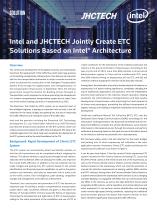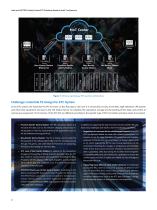
Catalog excerpts

Overview The continuous development of the global economy and urbanization has driven the rapid growth of the traffic flow, which puts huge pressure on the existing transportation infrastructure. It has become an important task for the transportation authorities in major countries around the world to promote the construction of the Intelligent Transportation System (ITS) through the digitalization and intelligentization of the transportation infrastructure. In September 2019, the Chinese government issued the Outline for Building China’s Strength in Transportation, which proposes to continue promoting the development of a modern comprehensive transportation system and to make China one of the world’s leading countries in transportation by 2035. The Electronic Toll Collection (ETC) system, as an important part of the intelligent highway, is playing an important role not only in the toll collection for the roads, bridges and parking lots, but also in improving the traffic efficiency and mining the value of the traffic data. Intel and the partners including the Shenzhen JHC Technology Development Co., Ltd.* (hereinafter referred to as JHCTECH) have launched the products and solutions for the ETC systems, which can collect, process and analyze the traffic data including the ETC data at the roadside edge and in the cloud, help users accelerate the deployment of the ETC systems, and lay the solid foundation for the ITS. Background: Rapid Development of China’s ETC System The ETC system can automatically detect and identify vehicles, so that the toll transactions can be completed without stopping the vehicles. This allows vehicles to quickly pass through the toll stations, alleviates their bottleneck effect of delaying the traffic, and improves the overall traffic efficiency. In addition to the toll collection for the roads, bridges and parking lots, ETC systems based on the vehicle identification and financial payment capabilities, as well as the gantry systems and networks, also play an important role in areas such as the traffic control, flow investigation, path labeling, congestion charges and management, and traffic law enforcement. Therefore, the construction and promotion of ETC has become an important part of building a modern comprehensive transportation system that is safe, convenient, efficient and green. In May 2019, the Ministry of Transport (MoT) of China issued the Notice on Vigorously Promoting the Development and Application of ETC on Expressways, calling for the active promotion of the installation and use of ETC to create conditions for the elimination of the traditional physical toll stations at the provincial borders of expressways. According to the plan, by the end of 2019, more than 80% vehicles in all provincial administration regions in China will be installed with ETC, more than 90% vehicles driving on expressways will use ETC, and fast toll collection without stopping the vehicles will be basically realized1. Among them, the elimination of province-border physical toll stations on expressways is of epoch-making significance, completely changing the way of expressway organization and operation, from the independent province-level operation to the national network operation, helping accelerate the informatization, intelligentization and high-quality development of expressways, while improving the travel experience of drivers and passengers, promoting the efficient development of logistics industry, and making an important contribution to the economic development. Unlike the traditional Manual Toll Collection (MTC), ETC uses the Dedicated Short Range Communications (DSRC) technology for the information exchange between the Road Side Unit (RSU) and the OnBoard Unit (OBU) to complete the vehicle identification, send relevant information to the backend servers through the network, and perform settlement processing based on the bank account information bound to the vehicle to achieve the automatic non-cash payments. ETC has been widely used in the toll collection for the roads, bridges and parking lots, of which expressway toll collection is the main application scenario. At present, China’s ETC system architecture for expressway toll collection is as shown in Figure 1. It can be seen from Figure 1 that the current China’s expressway ETC system includes the Non-Gantry Stations (including ETC Lanes and ETC/MTC Mixed Lanes) at the entrance and exit of the expressway, as well as the Province-Border Gantry Stations and Non-Border Gantry Stations located on the expressway, which can meet the automatic or manual toll collection requirements of passing vehicles (OBU vehicles and CPC vehicles). Among them, the Province-Border Gantry Station is a system erected above the expressway with functions such as charging and path labeling. It is equipped with RSUs that can communicate with the OBUs in the vehicles, as well as the high-definition license plate recognition (LPR) systems, vehicle classifiers, and vehicle detectors and other equipment. It can perform vehicle identification and charging under normal high-speed driving conditions, replacing the traditional province-border physical toll station that requires vehicles to slow down, therefore significantly improving the traffic efficiency.
Open the catalog to page 1
Intel and JHCTECH Jointly Create ETC Solutions Based on Intel® Architecture Provincial Center Toll Station Server Ministry-Station Direct Connection Ministry-Station Direct Connection Toll Station Server Non-Gantry Station (Entrance) Provincial Center Toll Station Server Province-Border Gantry Station Toll Station Server Non-Border Gantry Station No-Gantry Station (Exit) ETC/MTC Mixed Lane Vehicle Detector Vehicle Classifier HD License Plate Recognition Vehicle Detector Vehicle Classifier HD License Plate Recognition ETC/MTC Mixed Lane Figure 1: China’s expressway ETC system architecture...
Open the catalog to page 2
Intel and JHCTECH Jointly Create ETC Solutions Based on Intel® Architecture Solution: ETC IPC Solution based on Intel® Architecture JHCTECH has developed the ETC IPC series based on Intel® Architecture, including the following Intel® chips and technologies: Intel® Core™ Processor Family, Intel® vPro™, Intel® H110 & Q170 Chipsets, Intel® I219-LM & I211-AT Ethernet Controllers. They have the advantages of strong processing power, low power consumption, scalable performance, ultra high security and reliability, remote management and so on. Intel® Core™ Processor Family This series of...
Open the catalog to page 3All JHCTECH catalogs and technical brochures
-
KMDA-2630
2 Pages
-
KMDA-3301 Fanless Box PC
2 Pages
-
BRAV-7601 - S00X
2 Pages
-
BRAV-7601 - T00X
2 Pages
-
KMDA-5921-S002
2 Pages
-
KMDA-5921-S001
2 Pages
-
KMDA-5920-S002
2 Pages
-
KMDA-5920-S001
2 Pages
-
KMDA-5610 Fanless box PC
2 Pages
-
ECM-I910
3 Pages
-
KMDA Series
30 Pages
-
KMDA-3820
2 Pages
-
KMDA-2602-T002
2 Pages
-
KGEC-6310
2 Pages
-
KGEC-6301
2 Pages
-
KGEC-6300
2 Pages
-
BRAV-7521
2 Pages
-
BRAV-7520
2 Pages
-
ALAD-K1820T(P)
2 Pages
-
ALAD-K2120T(P)
2 Pages
-
STX-I905
2 Pages
-
STX-I902
2 Pages
-
STX-I720
2 Pages
-
ECM-I715
2 Pages
-
ECM-I713
2 Pages
-
MATX-I961
2 Pages
-
AXM-I951
2 Pages
-
AXM-I950
2 Pages
-
ECM-I909
2 Pages
-
EPI-I908
2 Pages
-
STX-907
2 Pages
-
KMDA-3230
2 Pages
-
WPPC-H1780T
2 Pages
-
MBPC-K304
3 Pages
-
SIGM-3250
2 Pages
-
KMDA-3920-ETC
2 Pages
-
SCC-3116
2 Pages
-
ALAD-211T
2 Pages
-
ALAD-191T
2 Pages
-
ALAD-181T
2 Pages
-
ALAD-171T
2 Pages
-
ALAD-151T
2 Pages
-
ALAD-121T
2 Pages
-
ALAD-101T
2 Pages
-
SIGM-2650
2 Pages
-
BRAV-7303
2 Pages
-
BRAV-7501
2 Pages
-
BRAV-7302
2 Pages
-
KMDA-3921
2 Pages
-
KMDA-3821
2 Pages
-
KMDA-3610
2 Pages
-
KMDA-3602
2 Pages
-
KMDA-3601
2 Pages
-
KMDA-3211
2 Pages
-
KMDA-3202
2 Pages
-
KMDA-3201
2 Pages
-
KMDA-2721
2 Pages
-
KMDA-2702
2 Pages
-
KMDA-2701
2 Pages
-
KMDA-2620
2 Pages
-
KMDA-2602
2 Pages
-
EPI-I903 EPI-I903
1 Pages
-
ALAD-K 1220 T
2 Pages
-
ALAD-171T/Monitor/JHC
2 Pages
-
ALAD-K1920T/Panel PC/JHC
2 Pages
-
ALAD-K1720T/Panel PC/JHC
2 Pages
-
ALAD-K1520T/Panel PC/JHC
2 Pages
-
ALAD-A1001T/Panel PC/JHC
2 Pages







































































